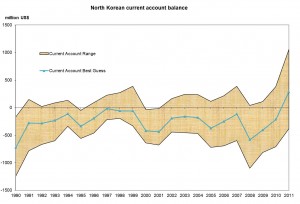The Bank of Korea has long reported that the DPRK has been running a current account deficit (see their summary report of the DPRK economy in 2011 here).
While working on their own statistics, however, Marcus Noland and Stephan Haggard assert that the DPRK may be running a current account surplus:
According to Noland:
[In all likelihood], North Korea has run current account deficits for most of its history. That meant that the country was consuming more than it was producing, and the difference had to financed from abroad. However, on our calculation, largely on the back of expanding trade with China, the current account went into surplus in 2011. Our preliminary calculations suggest that the country probably also ran a surplus in 2012.
This is bad news, both for North Korea and the rest of us. It is bad news for North Korea because as a relatively poor country, they should be running a current account deficit, importing capital, and expanding productive capacity for future growth. Instead, our calculation suggests that they are exporting capital. Consumption at home is being needlessly compressed (the recent UNICEF survey documents continuing chronic food insecurity for some significant part of the populace) and instead, money is flowing abroad, presumably to finance the future consumption of the elite. Steph Haggard, in a post last week, pointed to evidence that this capital may be flowing into accounts in China.
It is also bad news for us. If North Korea is running current account surpluses, then they are less vulnerable to foreign pressure.
The Wall Street Journal offered additional information:
Messrs. Noland and Haggard said that taking a pulse on North Korea’s economy is inevitably speculative. Pyongyang doesn’t release trade figures, so estimates are made based on data provided by third parties.
According to South Korean estimates, North Korea’s total trade with its only major ally, China, nearly tripled to around $5.6 billion between 2007 and 2011, and in 2011 it showed a deficit of $700 million in goods trade—a major component of its current account. For there to be an overall surplus, as the research of Messrs. Noland and Haggard suggests, other components in the current account would have to be more than enough to offset that goods-trade shortfall.
“If there were massive dollar remittances back home by overseas North Koreans or a sharp increase in foreign tourists to the North, it would be possible for North Korea to run a current-account surplus despite a trade deficit,” said a Bank of Korea official in Seoul. “But you never know the exact reasons unless you see the full data.”

